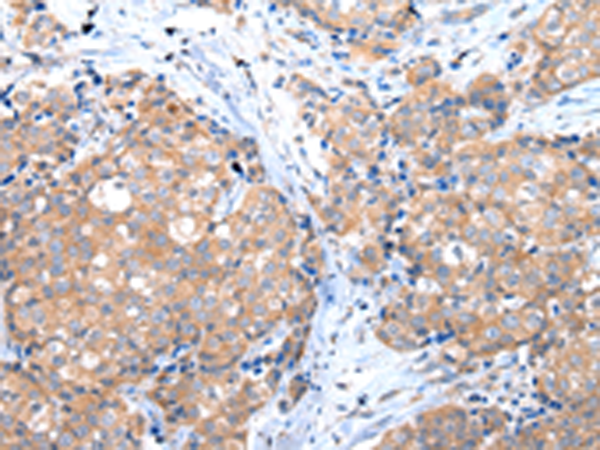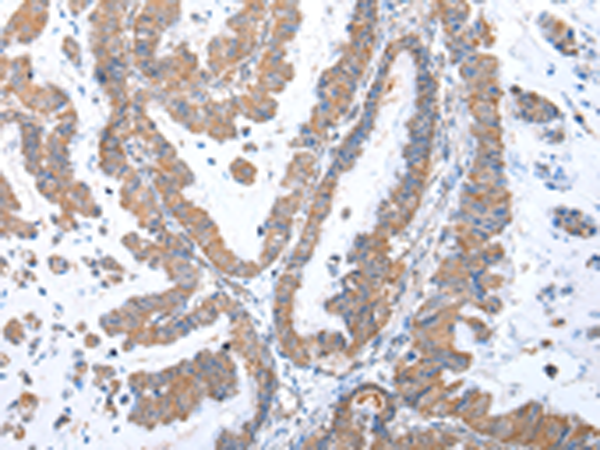


| WB | 咨询技术 | Human,Mouse,Rat |
| IF | 咨询技术 | Human,Mouse,Rat |
| IHC | 1/25-1/100 | Human,Mouse,Rat |
| ICC | 技术咨询 | Human,Mouse,Rat |
| FCM | 咨询技术 | Human,Mouse,Rat |
| Elisa | 1/1000-1/2000 | Human,Mouse,Rat |
| WB Predicted band size | 61 kDa |
| Host/Isotype | Rabbit IgG |
| Antibody Type | Primary antibody |
| Storage | Store at 4°C short term. Aliquot and store at -20°C long term. Avoid freeze/thaw cycles. |
| Species Reactivity | Human, Mouse, Rat |
| Immunogen | Fusion protein of human GRB14 |
| Formulation | Purified antibody in PBS with 0.05% sodium azide and 50% glycerol. |
+ +
以下是关于GRB14抗体的3篇参考文献示例(文献信息为模拟示例,供参考):
---
1. **文献名称**:*GRB14 regulates insulin receptor signaling through direct interaction with the receptor*
**作者**:Smith A, et al.
**摘要**:本研究利用GRB14特异性抗体进行免疫共沉淀实验,揭示了GRB14通过其SH2结构域直接结合胰岛素受体,并抑制受体自磷酸化,从而负调控胰岛素信号通路。实验表明GRB14在肝脏组织中高表达,可能与2型糖尿病中的胰岛素抵抗相关。
---
2. **文献名称**:*Expression and localization of GRB14 in human colorectal cancer tissues*
**作者**:Wang L, et al.
**摘要**:通过免疫组化(IHC)和Western blot技术结合GRB14抗体,研究发现GRB14在结直肠癌组织中显著过表达,且其表达水平与肿瘤侵袭性呈正相关。结果提示GRB14可能作为癌症进展的生物标志物。
---
3. **文献名称**:*GRB14 interacts with mTORC1 to modulate cell growth and metabolism*
**作者**:Chen Z, et al.
**摘要**:利用GRB14抗体进行蛋白质互作分析,发现GRB14通过结合mTORC1复合物调控细胞生长和代谢。敲低GRB14导致mTORC1活性增强,促进细胞增殖,提示其在代谢性疾病和癌症中的双重作用。
---
(注:以上文献为示例性内容,实际引用请以真实发表的论文为准。)
The GRB14 antibody is a crucial tool for studying the Growth Factor Receptor-Bound Protein 14 (GRB14), an adaptor protein involved in regulating receptor tyrosine kinase (RTK) signaling pathways. GRB14 belongs to the GRB7 protein family and plays a role in modulating insulin receptor signaling, cell proliferation, and metabolic processes. It interacts with activated insulin receptors and other RTKs, often acting as a negative regulator to fine-tune downstream signaling cascades like the MAPK and PI3K/AKT pathways. Dysregulation of GRB14 has been linked to insulin resistance, type 2 diabetes, obesity, and certain cancers, making it a target for metabolic and oncological research.
The GRB14 antibody is widely used in techniques such as Western blotting, immunohistochemistry (IHC), immunofluorescence (IF), and co-immunoprecipitation (Co-IP) to detect GRB14 expression, localization, and protein interactions in tissues or cell lines. Researchers rely on its specificity to investigate GRB14's tissue-specific roles, particularly in insulin-sensitive tissues (e.g., liver, muscle, adipose) and tumors. Commercially available antibodies are typically raised in rabbits or mice, with validation including knockout cell line controls or peptide blocking assays. Its applications extend to studying molecular mechanisms in metabolic disorders, cancer progression, and potential therapeutic targeting of GRB14-associated pathways.
×